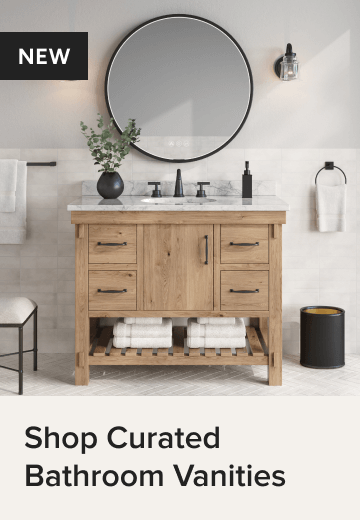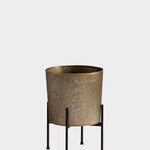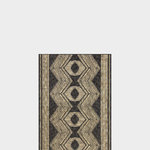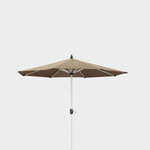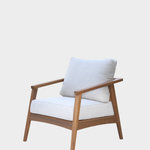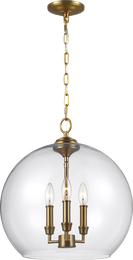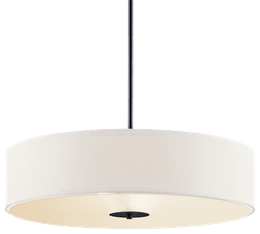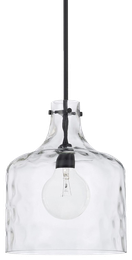FREE shipping on orders over $49!* Details
- All Products
- Hall
- Ceiling Lighting
- Pendant Lighting
Pendant Lights
Item 1 of 15
Sort by:
Price
99,055 Results
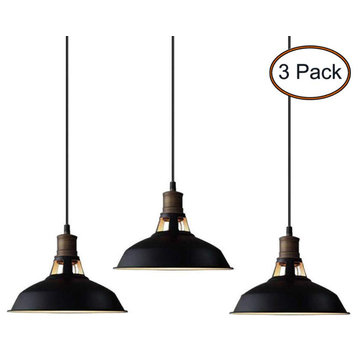
Florence Black Barn Pendant Light Loft Fixture, 12.2", 3-Packby mooseled(48)
$130
Crafting of solid metal, the pendant light’s barn shade boasts a rustproof matte black finish on the outer surface while it flaunts a white finish on the inner surface, injecting an industrial vibe to your home decor. What makes this pendant light so unique is the hollow design on the upper part of its lampholder and you can directly see the bulb through the hollow part, making the pendant light a amazing addition to your aesthetic.
It goes well in bar, bedroom, dining room, entryway, foyer, hallway, kids room, kitchen, living room and stairwell. Compatible with one 60-watt E26-based bulb (NOT included). Fully dimmable with compatible dimmer switch and a dimmable bulb.
It emanates inviting glow throughout your space, creating a relaxing atmosphere in your home. ETL listed for dry locations. A hardwired connection is applicable to the pendant light. It can be installed on sloped ceilings with an inclination angle of below 60 degrees.
It comes with a 47.2-inch adjustable cord. Dimension: 7.28 inches high
* 12.20 inches wide; canopy: 4.72 inches.
It goes well in bar, bedroom, dining room, entryway, foyer, hallway, kids room, kitchen, living room and stairwell. Compatible with one 60-watt E26-based bulb (NOT included). Fully dimmable with compatible dimmer switch and a dimmable bulb.
It emanates inviting glow throughout your space, creating a relaxing atmosphere in your home. ETL listed for dry locations. A hardwired connection is applicable to the pendant light. It can be installed on sloped ceilings with an inclination angle of below 60 degrees.
It comes with a 47.2-inch adjustable cord. Dimension: 7.28 inches high
* 12.20 inches wide; canopy: 4.72 inches.
Best Seller
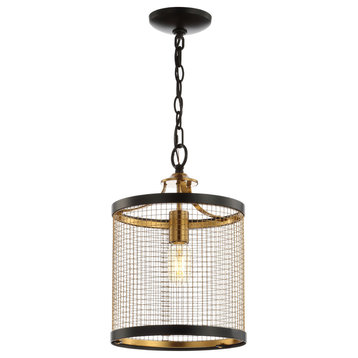
Elena 10" Lantern Metal LED Pendant, Black, Brass Goldby JONATHAN Y(43)
SALE
$122$319
A brass grid surrounds and softens the light from a single bulb in this stylish pendant. With black exterior rings, the reflection of the light on the golden interior creates a warm glow, while the sturdy construction makes it a work horse for any high traffic space. Best of all, the drop is adjustable so it can be altered to suit any ceiling height.
Features:
- A brass grid and black exterior rings construct this beautiful pendant light
- The available chain is 72" in length and can be altered by an electrician to suit your desired drop
- As this fixture must be hardwired, we recommend a professional electrician manage installation
- Eco-friendly 4W LED bulb included
- Takes one bulb and compatible with any 9W LED or 60W TYPE "A" or 13W CFL
- Color: Black/Brass Gold
- Body Material: Metal
- Includes: One (1) lamp(s)
Assembly RequiredDimensions:
- Lamp: 19 inches high x 10 inches wide x 10 inches deep
About us:
- You see a lamp.
- We see a decorative work of art.
- A perfectly curved shade casts a dramatic shadow on a floor. A silk cord you never want to hide. LED lightbulbs: as easy on the environment as they are on the eyes. The JONATHAN Y Lighting collection considers every detail from impeccably sourced materials to designer styling. And our prices are so attractive, we've transformed a functional necessity into a fashion accessory.
- JONATHAN Y Lighting - a fashion revolution in home decor.
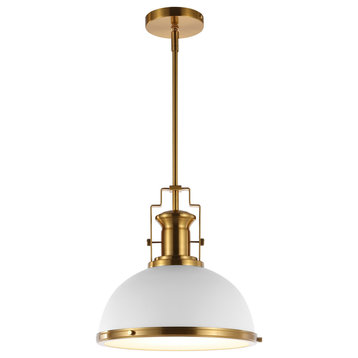
Stella Moravian Star Metal/Glass LED Flush Mount, Brass Gold/White, Width: 13"by JONATHAN Y(132)
$152
With its vintage detailing and classic good looks, this large kitchen pendant light adds an upscale touch to any traditional interior. The chrome finish is combined with a black metal hood for a crisp style contrast. The single LED bulb provides plenty of bright light, softened by a diffuser panel.
Features:
- Update your classic kitchen with the warmth and shine of our modern white dome and brass gold accent finish
- Suitable for ceilings up to ten feet, these pendants work with LED-compatible dimmers; professional installation is recommended
- As this fixture must be hardwired, we recommend a professional electrician manage installation
- Eco-friendly 9W LED bulb included
- Takes 1 bulbs and compatible with TYPE "A" 60W or CFL 13W or LED 9W
- Color: Brass Gold with White Shade
- Body Material: Metal
- Includes: One (1) lamp
- Assembly Required
Dimensions:
- Lamp: 21.5-51.5 inches high x 13 inches wide x 13 inches deep
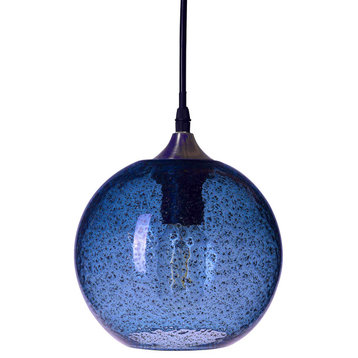
Mini Pendant Light Handblown, Light Blue, 7, Brushed Nickelby Casamotion(1068)
$54
- ETL listed. Bulb NOT included. Easy-to-install.
- BREAKAGE-PROOF PACKAGE: We guarantee FREE replacement for any damaged product.
- Also please note, that models brushed nickel finish have had a small change in the design, but the installation manuals have not been updated.
- Parts listed as C and D in the manual have been replaced by a black plastic nut that secures the glass shade to the fixture.
Best Seller
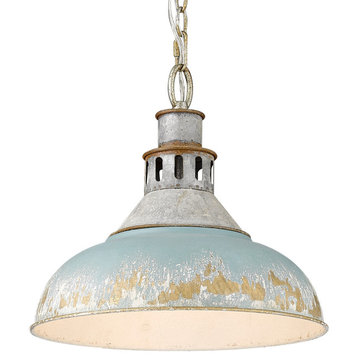
Kinsley Large Pendant, Aged Galvanized Steel With Antique Teal Shadeby Golden Lighting(134)
SALE
$177$198
Kinsley has a rustic, vintage appeal that is perfect for homes with eclectic or farmhouse decor. An Aged Galvanized Steel frame balances an antique shade. The hand-painted series has a distressed, weathered look. Choose a shade that fits your existing color scheme or opt to design around an Antique Teal, Ivory, Rust, Black Iron, or Red shade option. The pendants are large enough to hang over small dining room tables, over kitchen countertops, and in living rooms. Hang the fixtures alone or group balances together for a charming look.
- Number of Bulbs: 1
- Type of Bulb: A19
- Bulb Included Y/N: No
- Wattage: 100
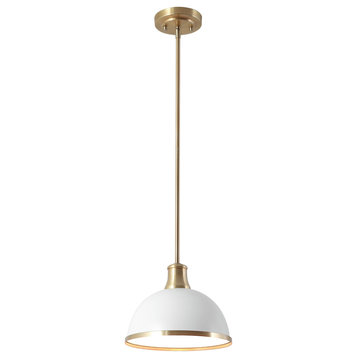
Beckett 1-Light Matte White Pendant with Matte Brass Accentsby Globe Electric(227)
$63
Mixing elements of industrial and farmhouse design with a decidedly modern glam style, the Beckett Collection by Globe Electric brings stunning visual appeal to your home. The wide mouth bowl shade has a farmhouse look while the matte brass accents and hanging bar offer an industrial design. Put together with a matte white finish, the overall style is very modern glam and will upscale every room.
Features
- MODERN GLAM: with round bowl shades and matte brass accents, the Beckett Collection by Globe Electric offers stunning modern glam design with hints of farmhouse and industrial style
- MATTE BRASS ACCENTS: the matte brass accent offers the perfect pop of gold color and adds a glamorous look to a modern design
- BULB REQUIREMENTS: 1x E26/Medium Base 60W Bulb (sold separately) - Compatible with LED, Incandescent and Halogen Bulbs - LED or Incandescent recommended
- EASY INSTALL: includes all mounting hardware for quick and easy installation - can be installed on a sloped or vaulted ceiling - Maximum Hanging Height: 51.93"; Minimum Hanging Height: 12"
- DIMMABLE: fully dimmable with compatible dimmer switch to create the perfect atmosphere (dimmer switch sold separately)
- MAKE IT SMART: automate your flush mount ceiling light by adding a Globe Electric Smart bulb - simply screw it in and create different lighting solutions with your phone - the options are endless!
- BRING THE COLLECTION HOME: check out the other piece of the Beckett Collection by Globe Electric to bring a cohesive look throughout your home
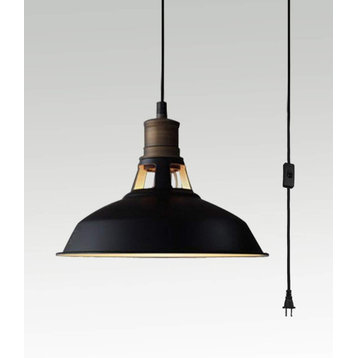
Barn Mini Metal Pendant Light 1 Light, Plug-inby Ecopower Light LLC(1173)
SALE
$64$129
- Vintage metal plug in pendant light with on/off switch, white interior
- ETL listed, hard-wired, The bulb NOT included.
- H: 6.3-inch, Cord length: 10 ft.
- Simplicity edison industrial hanging light fixture
- Hardwire,includes canopy, cord, socket and aged steel fixture
- Assembled Height: 6.3 inches
- Assembled Width: 12.2 inches
- Cord length: 10 ft inches (adjustable)
- Package Weight: 3.5 pounds
- Package Dimensions: 13.2 x 12.9 x 8 inches
- Style: Vintage
- Finish : Painted
- Number of Lights: 1
- Maximum Compatible Wattage: 60 watts
- Voltage: 110 volts
- Specific Uses: General purpose, indoors
- Fixture Features: Metal shade pendant light
- Shade Color: Black
- Material: Metal
- Light Direction: Downlight
- Base Type: E26
- Type of Bulb: Incandescent or LED bulbs, Bulb NOT included.
- Certification: ETL / ETL Listed
- Power Source: Hard-wired
Best Seller
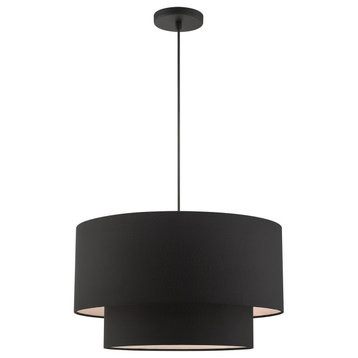
Black Modern, Urban, Versatile, Retro, Scandinavian Pendantby Livex Lighting Inc.(151)
SALE
$184$521
The Bainbridge collection is both modern and versatile. The hand-crafted black fabric hardback shade is set off by the silky white fabric on the inside setting a pleasant mood. The three-light double drum shade adds character to this handsomely styled pendant. Perfect fit for the living room, dining room, kitchen and bedroom. This sleek design is shown in a black finish.
- Bulb Type: Medium Base
- Number of Bulbs: 3
- Bulbs Included?: No
- UL Listed: ETL
- Bulb Wattage: 60
- Hardwire or Plug: Hardwire
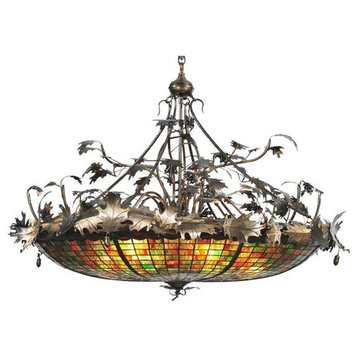
50W Greenbriar Oak Inverted Pendantby Meyda Lighting(6)
SALE
$6,080$8,434
Every Meyda Tiffany item is a unique, handcrafted work of art. Natural variations, in the wide array of materials that we use to create each Meyda product, make every item a masterpiece of its own. Photographs are a general representation of the product. Colors and designs will vary.
- Bulb Type: MED
- Bulb Wattage: 60
- Bulb Quantity: 6
Best Seller
Hampton Hill Auburn Bell Shaped Glass Pendant, Goldby Olliix(1058)
$94
Illuminate your home decor with the simple, industrial style of the Hampton Hill Auburn Bell Shaped Glass Pendant. Featuring a bell-shaped glass shade this ceiling pendant could be mounted on vaulted or angled ceilings. A metal finish completes the look and complements a variety of kitchens and entryways. Comes with a 2 year limited warranty. Professional installation and assembly is required. 1 Type-A light bulb is needed and NOT included. Spot clean only.
Size Description:
- 1 Pendant:9" Dia x 95.5"H
- Body Size:9" Dia x 14.5"H
- Shade Size: 7.375" Dia x 9" Dia x 11"H
- Socket Size: 1.5" Dia x 2.5"H
- Cord Length: 80"
- Canopy Pendant:5" Dia x 1"H
- Number of Bulbs Needed:1
Material:
- Material: 70% glass, 25% iron, 5% cord
- Base Material: Iron
- Base Finish: Gold
- Shade Material: Glass
Features:
- Metal base with bell shape clear glass shade
- Adjustable Cord hanging pendant
- Sloped ceiling compatible
- 1 Type A bulb is needed (not included), wattage 60W incandescent/13W CFL/9W LED
- Dimmable with compatible dimmer switch and bulb (not included)
- Mounting hardware Included; Professional installation is required
- Provides downward light
Best Seller
4-Light 12" Modern Gold Pendantby Millennium Lighting Incorporated(97)
SALE
$174$274
This 4 Light Candle Bulbs 60W 12 in. Modern Gold Pendant is sure to add style to your decor. No bulbs included, UL Listed and must be hardwired
Best Seller
Luxury Industrial Pendant Light, Nottingham Series, Olde Bronzeby Urban Ambiance(31)
$128
THE NOTTINGHAM COLLECTION:
- The classic allure of the Nottingham family of lighting fixtures is not devoid of an enduring industrial flavor. The statement-making design features a schoolhouse-inspired globe glass nicely nestled in vintage-fashioned metal fittings.
- Straight, curved, ringed, and gooseneck arms dominate the fixture suspension department. Before the suspension of the artistic clear glass materializes, an intricate mechanical journey must take place at its peak. Each globe is defined by a squarely stepped seal with clasping knobs around the glass�s mouth. The glass then embraces the stepped rhythm as it bulges into a stepped descent. Ushering the final bulging step is a decorative trim accent pronounced by complementing knobs.
- Available in Polished Nickel and Olde Bronze as chandeliers, pendants, and bath lights.
PRODUCT INFORMATION:
- MODEL NUMBER: UHP2535, UHP2535
- PRODUCT COLLECTION: Nottingham
- INSTALL LOCATION: Indoor
- FIXTURE TYPE: Pendant
- FINISH: Olde Bronze
- CONSTRUCTION MATERIAL: Steel
ABOUT THE DESIGN:
- DESIGN FEATURES: Glass Globe, Two Tone
- SHADE CHARACTERISTICS: Clear
- FIXTURE FORM/SHAPES: Circular, Jar
- FINISH TONES: Bronzes, Browns
ELECTRICAL AND INSTALLATION:
- FIXTURE BODY: 11-1/4"H x 11"W x 11"Dep
- HANGING HEIGHT: 19.25" min - 66.25" max
- CEILING OR WALL PLATE DIMS: 0.75" x 5" x 5"
- FIXTURE WEIGHT (IN LBS): 5.59 lbs
- LOCATION RATING: Dry Locations
- SLOPED CEILING COMPATIBLE: Yes
- REVERSIBLE (UP/DOWN) OPTION: No
- VOLTAGE: 110/120 V
- NUMBER OF BULBS: One (1), E26 Medium Base, 75W (Not Included)
- RECOMMENDED BULB SHAPE: ST19
- COMPATIBILITY: LED and Dimmable Bulbs
STYLE INFLUENCES:
- INDUSTRIAL: Raw and edgy, showcasing exposed brick, metal, and wood, often in loft spaces or converted warehouses.
- ART DECO: Known for its geometric shapes, bold colors, and lavish ornamentation, representing luxury, glamour, and technological progress of the 1920s and 1930s.
- CRAFTSMAN: Emphasizes handcrafted woodwork, quality materials, and sturdy construction, often with a warm, earthy palette.
- CLASSIC: Timeless elegance, symmetry, and harmonious proportions, often featuring antique furniture and rich materials.
PRODUCT TAGS:
kitchen above counter island lighting lite fixture hanging over ceiling drop chain down bedroom dining table diningroom large drum small bulbs living room livingroom mounted above pendent matchingEffervescent Glass Pendant Lighting, Clear, Pack of 1by Casamotion(201)
$48
ETL listed. Bulb NOT included. Easy-to-install.
CAUTION: PLEASE READ BEFORE PURCHASE: EACH PRODUCT IS INDIVIDUALLY MOUTH-BLOWN AND HAND FINISHED BY SKILLED CRAFTSMEN. UNLIKE MACHINE-MADE PRODUCTS, EACH CASAMOTION PRODUCT IS THEREFORE UNIQUE IN ITS SHAPE AND COLORING. MINOR COLOR AND SHAPE VARIATIONS ARE POSSIBLE.
BREAKAGE-PROOF PACKAGE: We guarantee FREE replacement for any damaged product.
Ideal to hang above kitchen island, table , entryway, hallway, bedroom, dining room, kit, bar, restaurant, farmhouse, can be used in high&slope ceiling.
CAUTION: PLEASE READ BEFORE PURCHASE: EACH PRODUCT IS INDIVIDUALLY MOUTH-BLOWN AND HAND FINISHED BY SKILLED CRAFTSMEN. UNLIKE MACHINE-MADE PRODUCTS, EACH CASAMOTION PRODUCT IS THEREFORE UNIQUE IN ITS SHAPE AND COLORING. MINOR COLOR AND SHAPE VARIATIONS ARE POSSIBLE.
BREAKAGE-PROOF PACKAGE: We guarantee FREE replacement for any damaged product.
Ideal to hang above kitchen island, table , entryway, hallway, bedroom, dining room, kit, bar, restaurant, farmhouse, can be used in high&slope ceiling.
Best Seller
Satin Nickel Mini-Pendant Light with Water Glassby Destination Lighting(31)
$125
Satin Nickel Mini-Pendant Light with Water Glass Modern satin nickel 1 light mini-pendant light with clear water outer / satin white inner water satin glass shade. Takes one 100-watt medium base frosted light bulb (not included). The mini-pendant light comes with one 6-inch and three 12-inch downrods. Suitable for installation in dry locations only. 120 volts line voltage. UL / CUL certified.
Millennium Lighting Corona Pendant, Satin Nickelby Millennium Lighting Inc(138)
SALE
$174$226
This Georgian inspired work of art aglow and will give an entry way a look of distinction. This hanging lantern is sized at 12” x 17” and the 4-Candle 60W bulbs complete this elegant piece. Pendants serve as both an excellent source of illumination and an eye-catching decorative fixture.
- Bulbs are not included
- ADA Compliant: No
- UL Listed: Yes
24W Fulton Prime Lantern Pendantby Meyda Lighting
SALE
$4,545$5,501
Custom crafted of Solid Brass, this Craftsman Signature cylindrical shaped lantern reveals two clusters of four light candelabras that project ambient light through Clear Seeded glass. The frame and hardware are featured in a stunning Cafe Noir finish. The fixture is handmade by Meyda artisans in our manufacturing facility in Yorkville, NY and is ideal for outdoor and indoor applications. Custom designs, styles, sizes and dimmable energy-efficient lamping options are available.
- UL Approved: Yes
- Bulb Type: CNDL
- Bulb Quantity: 8
- Bulb Wattage: 40
- Bulbs Included: No
Best Seller
Effimero 3-Light Cluster Pendant, Blackby Linea di Liara(635)
$167
The Effimero 3 light cluster pendant light fixture features a modern design that adds an industrial look to any setting. This multi light chandelier offers a black finish, exposed hardware and clear glass shades. Adjustable fabric cords allow for customization of the length of the lights.
- Ideal above kitchen islands, as a dining room hanging light, in a hallway or foyer
- Quality metal construction with a black finish and clear glass shades; 1-year manufacturer warranty with US based customer service; UL listed
- Measures 12 inches wide; clear glass shades measure 3.5 inches in diameter by 8 inches high
- Adjustable cords, 12.75 inches minimum hanging height and 57 inches maximum hanging height
- Uses three E26-base bulbs 60W max (not included); dimmable when used with a dimmable bulb and compatible dimmer switch
- Must be hardwired, installation by a licensed electrician recommended
Golden Lighting 3118-M1L BLK-SD Hines Mini Pendant, Matte Blackby Golden Lighting(302)
SALE
$111$154
- Transitional Style Suitable For A Variety Of Decors
- Simple, Traditional Silhouettes
- Durable Steel Construction
- Offered In 4 Finishes: Chrome, Pewter, Rubbed Bronze And Black
- Available With Opal Or Seeded Glass Shades
- Includes Three 12" Rods And One 6" Rod
- May Be Mounted On Sloped Ceiling
- Pivoting Feature Allows For Directional Lighting
- Chain, Cable, Or Rod : Rod
- Rod Qty : 1Ea 6", 3Ea 12"
- Chain Length : Na
- Wire Length : 10'
- Shade Finish : Seeded Glass
- Shade Diameter : 6.875"
- Shade Height : 4.75"
- Canopy/Backplate Dimension : 5" Dia X 0.875"E
- Fixture Application : Damp Location
- Number Of Bulbs : 1
- Fixture Wattage : 1 X 100W(M)
- Max Wattage : 100
- Total Wattage : 100
- Uses Bulb Type : Incandescent, Type A
- Bulb Included : No
- Voltage : 120
- Dimmable : Yes
- Slope Ceiling : Yes
- Close-To-Ceiling : Yes
- Convertible : Yes
- Bulb Base : E26/Medium
- Color Rendering Index (Cri) : Na
- Color Temperature : Na
- Shade Material : Glass
Meridian 5-Light Pendant, English Bronzeby Livex Lighting Inc.(94)
SALE
$270$483
A triple drum shade adds character to this handsomely styled pendant light. Update your decor with the clean styling of this contemporary five light pendant from the Meridian collection. Features a lovely hand crafted oatmeal color fabric hardback shade and frosted diffuser for subtle illumination.
- Glass Type/Shade Type: Hand Crafted Oatmeal Color Fabric Hardback Shade
- Finish: English Bronze
- Material: Steel
- Number of Bulbs: 5
- Bulb Base Type: Medium Base
- Max Wattage: 60
- Suitable for Dry Locations? Yes
- Suitable for Damp Locations? Yes
- Suitable for Wet Locations? No
- ADA Compliant? No
Milano 4.75" Mini Pendant Marble Swirl Glass Oil Rubbed Bronzeby Vaxcel(200)
SALE
$90
The Milano collection of mini pendant lights feature softly radiused hand-blown glass that gracefully blends into almost any decor. Because each glass is handcrafted utilizing century-old techniques, no two pieces are identical. The marble swirl colored glass has tones of gray and silver and is housed in an oil rubbed bronze finish for a contemporary and artistic look. Install this mini pendant individually or in a group; ideal for kitchens, dining areas, or bar areas.
FEATURES:
- Oil rubbed bronze finish offers a distinctive look and quality steel construction
- Marble swirl glass provides bright illumination and a transitional feel
- Uses 1 x 60 watt E26 medium base bulb (not included); led compatible
- Dimmable for desired illumination levels when used with dimmable bulbs and compatible wall switch
- 4.75-in W x 9.75-in H x 4.75-in D
- Adjustable height; 12.75-72.75 inches using 72 inches of included cord
- Mounting hardware and instruction manual included for easy installation
- Interior dry rated; ideal for dining rooms, kitchens, islands, bar areas, or any other dry area of your home
- UL, C UL listing demonstrates this product has met requirements for product safety standards
Best Seller
Duncan 1 Light Pendant, Rod, Black, Matte Black Shadeby Golden Lighting(341)
SALE
$133$341
Transform the look of your room with this classic, vintage-inspired fixture by Golden Lighting. Golden Lighting's Duncan collection is contemporary style with an industrial feel. The collection features a variety of simple, traditional silhouettes that are a nod to a bygone era. A variety of plated and painted metal shade finishes are offered in combination with durable Aged Brass, Black, Chrome or Pewter fixture bodies. The Rubbed Bronze fixtures are paired with Rubbed Bronze shades. This large, rod-hung pendant features a glass diffuser and is comfortably sized for a small nook or island. The pendant may be hung individually or grouped over a bar. This matte black 1-light pendant with rod is paired with a matte black shade. The shade is a soft, matte black .
Trade Winds Lighting 1-Light Pendant Light In Natural Brassby Trade Winds Lighting(81)
$77
This 1-Light Pendant Light From Trade Winds Lighting Comes In A Natural Brass Finish. It Measures 10" High X 6" Long X 6" Wide. This Light Uses 1 Incandescent Bulb(S). This light requires 1 , 60W Watt Bulbs (Not Included) UL Certified.
Rushton 1-Light Brushed Nickel Clear Glass Industrial Pendant Hanging Lightby Progress Lighting(1)
$134
Integrated historical industrial elegance into your home decor with the Rushton Collection 1-Light Brushed Nickel Clear Glass Industrial Hanging Pendant Light.
The sleek stem and industrial light base are coated in a beautiful brushed nickel finish. A light source glows from within the clear glass shade for elegant illumination.
For ideal illumination, use 1 medium base bulb that is sold separately (100w max - LED/CFL/incandescent). The hanging light is compatible with dimmable bulbs.
The hanging light's industrial elegance is ideal for any foyer, dining room, kitchen, breakfast nook, entryway, living room, or stairway in farmhouse and urban industrial style settings.
It's time to breathe new life into the mundane every day with timeless and truly transformative lighting. Make your purchase today to begin your journey to a whole new lighting experience. Progress Lighting products are designed for exceptional quality, reliability, and functionality.
The sleek stem and industrial light base are coated in a beautiful brushed nickel finish. A light source glows from within the clear glass shade for elegant illumination.
For ideal illumination, use 1 medium base bulb that is sold separately (100w max - LED/CFL/incandescent). The hanging light is compatible with dimmable bulbs.
The hanging light's industrial elegance is ideal for any foyer, dining room, kitchen, breakfast nook, entryway, living room, or stairway in farmhouse and urban industrial style settings.
It's time to breathe new life into the mundane every day with timeless and truly transformative lighting. Make your purchase today to begin your journey to a whole new lighting experience. Progress Lighting products are designed for exceptional quality, reliability, and functionality.
Lighting Information:
- Bulb type: Incandescent
- Number of bulbs: 1
- Bulb(s) not included
- CULus
- Bulb wattage: 100 W
- Hardwired
Harrow 1-Light Matte Black Pendant, Clear Glass Shadeby Globe Electric(268)
SALE
$61$73
The mid-century modern design trend is a throwback to the design style of primarily the 1950s and 60s when lighting was a source of beauty as well as illumination. The Harrow 1-Light Pendant utilizes a stunning shape, a matte finish and gold accents to bring mid-century modern design into your home. The curved clear glass shade has a mid-century shape while the matte black finish and gold accent socket has a modern touch. Instead of hanging from a chain or wire, the Harrow Pendant is suspended from a hanging bar that is separated into four equal pieces to adjust the height so you can place it where you need it most. Check out the other items in the Harrow collection - with a wall sconce and a semi-flush mount ceiling light you can decorate your whole home with one trendy style.
- MID-CENTURY MODERN: matte-black, gold accents and a shapely glass shade are brought together as the epitome of mid-century modern design
- DIMMABLE: fully dimmable with a compatible dimmer switch to create the perfect atmosphere (dimmer switch sold separately)
- EASY INSTALL: includes all mounting hardware for quick and easy installation - can be installed on a sloped or vaulted ceiling
- BULB REQUIREMENTS: 1x E26/Medium Base 60W Bulbs (sold separately)
- BRING THE COLLECTION HOME: check out the other pieces of the Harrow Collection by Globe Electric to bring a cohesive look throughout your home
Best Seller
Kira Home Wyer 8" / Farmhouse Pendant Light, Glass Cylinder Shade, Dimmableby Kira Home(14)
$70
- [RETRO MODERN DESIGN] This modern pendant light radiates elegance, showcasing an oil rubbed bronze finish and classy industrial accents. The mid century hanging light includes a cylindrical clear glass jar shade, casting a warm glow over its installed space, making it a prime choice amongst designers and builders
- [EASY INSTALLATION] Perfect in pairs over a kitchen island / table, above dining room / breakfast tables, in nook or kitchenette areas, above a sink, or in living rooms over a coffee table. This metal pendant light with tapered shade is very popular in hotels, custom homes and luxury apartments. Its adjustable cord can easily accommodate rooms with high, low or sloped ceilings, effortlessly transforming your living space
- [ETL LISTED FOR YOUR SAFETY] ETL listed for dry locations. Uses (1) LED, CFL, or up to 60W traditional incandescent medium base bulb. Bulb sold separately. Pair with an Edison Bulb for a vintage look. Dimmer compatible. Includes all hardware for quick installation of this farmhouse jar pendant light fixture
- [DIMENSIONS] Adjustable Height: 14" ~ 104", includes 8 feet of cord. Pendant Light: 7.75" (H) x 4.5" (D), Shade: 6.75" (H) x 4" (D), Canopy: 5" (D)
- [FITS MANY DECOR STYLES WITH UNMATCHED WARRANTY] This stylish modern mini pendant light with a open bottom clear glass jar shade complements many decor styles from mid century modern and contemporary, to traditional and retro designs. Enjoy peace of mind with our 1-year warranty, guaranteeing your complete satisfaction
- Collection: Wyer
- Height: 7.75"
- Width: 4"
- Depth: 4"
- Finish: Bronze
- Material: Metal
- Shade: Clear
Best Seller
Hines 1-Light Pendant, Black, Seeded Glassby Golden Lighting(111)
SALE
$137$239
Hines is suitable for a variety of decors. The transitional style is a marriage of traditional silhouettes with modern finishes. This pendant may be hung individually or arrayed as a set.
Features:
- Constructed of durable steel
- Comes with a glass shade
- Requires (1) 100 watt max medium (E26) bulb
- Includes (1) 6" and (3) 12" downrods
- Capable of being dimmed
- UL and CUL rated for dry locations
- Covered under Golden Lighting's 1 year limited warranty
Dimensions:
- Height: 13-1/8"
- Width: 13-1/2"
- Shade Height: 7-1/2"
- Shade Diameter: 13-1/2"
- Canopy Height: 7/8"
- Canopy Diameter: 5"
Specifications:
- Bulb Base: Medium (E26)
- Number of Bulbs: 1
- Bulb not Included
- Watts Per Bulb: 100 watts
- Wattage: 100 watts
- Voltage: 120 volts
Best Seller
Kira Home Bellevue 18" Farmhouse Lantern Pendant Light, Adjustable Foyerby Kira Home(18)
$140
- [TWO-TONED FARMHOUSE DESIGN] Open 4-light farmhouse pendant chandelier makes a captivating statement, boasting a classy black frame and warm brass accents. Its modern candlestick sockets are an instant upgrade to your dining room or foyer. This rectangular geometric industrial pendant exudes a minimalist charm, creating a warm and welcoming ambiance that envelops the entire room
- [EASY INSTALLATION] Ideal over kitchen island / tables, above dining room / breakfast tables, in small nook / kitchenette areas, or in living rooms or over bars / counters. This pendant light is very popular in custom homes and apartments due to its versatility. Its adjustable stems / downrods can easily accommodate rooms with high, low or sloped ceilings, for effortless transformation of your living space
- [UL LISTED FOR YOUR SAFETY] UL listed for dry locations. Uses (4) LED, CFL or up to 60W Type B incandescent candelabra base bulbs. Complete your rustic feel with vintage Edison style bulbs. Bulbs sold separately. Dimmer compatible. Includes all hardware for quick installation of this quality modern farmhouse hanging light fixture
- [DIMENSIONS] Adjustable Height: 27" ~ 69", includes (2) 6" and (3) 12" downrods. Fixture Body: 18" (H) x 15.75" (W) x 15.75" (L), Canopy: 5" (D)
- [FITS MANY DECOR STYLES WITH UNMATCHED WARRANTY] This lantern pendant light chandelier with black and warm brass finish and candle / candlestick sockets complements all decor styles and remodels from rustic and modern, to contemporary and industrial designs. Enjoy peace of mind with our 1-year warranty, guaranteeing your complete satisfaction
- Collection: Bellevue
- Height: 18"
- Width: 15.75"
- Depth: 15.75"
- Finish: Black
- Material: Metal
Pagoda Lantern Metal LED Pendant, Chrome, 12"by JONATHAN Y(1351)
SALE
$158$326
This classic lantern pendant light features a metal caged frame of negative space with exposed bulbs that illuminate from within the center. The shape of the fixture is inspired by iconic street oil lanterns. The pendant light suspends from a chain link that is adjustable to allow the fixture to hang only 22"down, or up to 94" from your ceiling, where it anchors with a round metal canopy.
Features:
- An open lantern-style design gives this pendant a welcoming aesthetic
- Adjustable chain link makes this fixture suitable for most ceiling heights
- Eco-friendly 4W LED bulb included
- Takes four bulbs and compatible with any 9W LED 40W TYPE "B" 13W CFL
- As this fixture must be hardwired, we recommend a professional electrician manage installation
- Color: Chrome
- Body Material: Metal
- Includes: One (1) lamp(s)
- Assembly Required
Dimensions:
- Lamp: 18" high x 12" wide x 12" deep
Best Seller
Chloe Lighting Walter Industrial 1 Light Pendant, Matte Blackby CHLOE Lighting, Inc.(44)
SALE
$39$114
WALTER, this 1-light pendant features a black finish that will complement many loft, urban, industrial and transitional decors. The metal shade adds interest and completes this retro look.
- (1) 100 Watt max E26 Type A Bulb (not included)
- Hardwired
- Steel
- Downlight
- Indoor Setting
- Finish: Matt Black
30 Wide Metro Fusion Ramoscelli Inverted Pendantby Meyda Lighting
SALE
$3,152$4,060
Every Meyda Tiffany item is a unique, handcrafted work of art. Natural variations, in the wide array of materials that we use to create each Meyda product, make every item a masterpiece of its own. Photographs are a general representation of the product. Colors and designs will vary.
- UL Approved: Yes
- Hardwire or Plug: Hardwire
- Bulb Quantity: 4
- Bulb Type: MED
- Bulb Wattage: 100
- Bulbs Included: No
Best Seller
Millennium Lighting Corona Pendant, Matte Blackby Millennium Lighting Inc(139)
$231
This Georgian inspired work of art aglow and will give an entry way a look of distinction. This hanging lantern is sized at 16” x 22 1/2” and the 4-Candle 60W bulbs complete this elegant piece. Pendants serve as both an excellent source of illumination and an eye-catching decorative fixture. Bulbs are not included.
- ADA Compliant: No
- UL Listed: Yes
Best Seller
4-Light 16" Modern Gold Pendantby Millennium Lighting Incorporated(42)
SALE
$207$976
This Georgian inspired work of art aglow and will give an entry way a look of distinction. This hanging lantern is sized at 16” x 22 1/2” and the 4-Candle 60W bulbs complete this elegant piece. Pendants serve as both an excellent source of illumination and an eye-catching decorative fixture. Bulbs are not included.
- ADA Compliant: No
- UL Listed: Yes
R Series Collection 10" Corded RLM Pendant, Satin Blackby Millennium Lighting Inc(63)
SALE
$95$115
- 10" Deep Bowl RLM Shade with 12 foot cord and Canopy included, wire guard is sold separately.
- UL Listed For Damp Locations
- Number of Bulbs required: 1
- Type of Bulbs: A Lamps
- Wattage: 200W
- Bulbs are not included
- ADA Compliant: No
- UL Listed: Yes
Livex Lighting 1 Light Steel Single Pendant With Brushed Nickel Finish 41322-91by Livex Lighting Inc.(6)
SALE
$67$102
Suspended from a simple black cord, this mini pendant is contemporary and urban. An brushed nickel finish adorns the steel cage, creating a handsome, rugged look that recalls the industrial age.
Features
- Glass Type/Shade Type: Brushed Nickel Geometric Metal Shade
- Bulb Base Type: Medium Base
- Max Wattage: 60
- Wire: 6'
- Canopy Size: 5" Dia x 1" H
- Style: Urban
- Collection: Bedford
- Suitable for Dry Locations: Yes
- Suitable for Damp Locations: Yes
- Suitable for Wet Locations: No
- Uplight or Downlight: No
- ADA Compliant: No
- Color: Brushed Nickel
- Material: Steel
- Made In China
Hammered Glass Pendant Light with Brass Ring, 1 Ceiling Hanging Light, Gray, Mediumby Casamotion(79)
$62
- Size: 6.1" Diameter, 11.8" Height, 70.8" Adjustable Hard Wire Cord. Ul Listed. Bulb Not Included. Easy-To-Install.
- Handmade&Mouthblown: Each Product Is Individually Mouthblown And Hand-Finished By Skilled Craftsmen. Slight Variations May Occur.
- Soda-Lime Glass: All Casamotion Handmade Glass Is Produced From Soda-Lime Glass-Which Is Lead Free, Unlike Crystal.
- Breakage-Proof Package: We Guarantee Free Replacement For Any Damaged Product.
Miro Collection 3 Light Pendant Lamp, Vintage Black Finish 20"D x 11.75"Hby Elegant Lighting Inc(41)
SALE
$182$262
Description:
The raw power and audacious simplicity of Miro collection hanging fixtures will lend a commanding presence to your home- especially in a kitchen, living room, office, or studio space. The bold, textured cylindrical shade hangs from a rugged chain and disk-shaped mounting plate. Three exposed bulbs (Not included) hang from a hidden internal crosspiece and create a curious effect on the color of the interior. Available in a vintage-Black or manual-brass finish with two size options. 3-lights can accommodate either incandescent, LED, CFL energy saving lamps (Not included). Includes matching chain and canopy. Available in a vintage-Black or manual-brass finish with two size options. California Proposition 65 warning required: Yes. WARNING: This product can expose you chemicals including lead and lead compounds, which are known to the State of California to cause cancer and birth defects and other reproductive harm. For more information go to: www.P65Warnings.ca.gov. Height is adjustable: Yes. Hanging device adjustable: Yes. Type of hanging device: Chain. Lighting: Chain, Rod, or Cord length and finish: 60 and Vintage Black. Lighting: Chain, Rod, or Cord part#: chain04PBK. Dry/Wet/Damp Location: Dry Rated. Number of tiers: 1. Dimmable: Yes.Features:
- Bulb shape: medium; bulb not provided. Bulb wattage: 40. Max wattage: 120. Voltage: 110V-125V. UL,ULC standard. Product weight: 9.4
- Light Direction: All Around. Number of lights: 3. Socket Type: E26. Wire color: Black.
- Product Warranty: 2 Years. Include bulbs: No. Lighting Canopy: Yes. Canopy Dimensions: 4.7"W x 1"H. Minimum and Maximum Hanging: 20.2"H x 73.2"H.
- Hardware finish: Vintage Black. Hardware material: Metal. Fixture material: Metal. Assembly Required: No. Shade Included: No. wire included: 78.7.
- Product Dimensions: 20"D x 20"W x 11.75"H. Type: Lighting: Pendant. Style: Transitional. Collection: Miro. Finish color: Vintage Black.
Pendant lighting can be very a versatile tool in home design. Light up one specific area with a single pendant light, or use multiple together to illuminate a wider space and make a statement. Unlike flush-mounts, pendant lights typically hang from the ceiling by either chain, wire, or stem to give a more dramatic feel and add interest to a space (while lighting the way, of course!). As you shop for the perfect pendant light fixture for your home, keep the following information in mind to help guide your decision.
You have an abundance of choice when it comes to pendant lighting styles. Here are some of the more common types you may want to consider, or eliminate, from your selections based on your needs.
Mini lights - Mini pendant lights are 12 inches wide or less and have a more narrow stream of light that can shine on smaller details that you wish to put the spotlight on. Cluster a group of them over a kitchen island to mimic the lighting of one bigger pendant light fixture. Try a kitchen island light if you want the larger pendant look in lieu of multiple smaller fixtures.
Drum - Their larger size makes drum pendant lighting more qualified to light up a wider area, including smaller rooms or a defined space, like a dining area. The simplicity of their style makes them a winner in many different decor tastes.
Bowl - The uplighting of bowl pendants will reflect off the ceiling to give a softer, ambient glow. This is often better for general, or ambient, lighting where you aren’t needing to focus on specific tasks.
Bulb - When you want the bare minimum, go for a bulb pendant. This style puts the emphasis on the bulb and often the cord that it hang from, so pick a unique light bulb like an edison style.
Dome - The downlighting of a dome pendant will be less focused than mini fixtures but will give more of a task lighting effect than the bowl style might.
Decorative - Need a fun foyer pendant or a statement piece for your dining table? Try something with a more decorative touch, like a lantern pendant light or novelty pendants.
It’s important to consider your current wiring situation before commiting to a new fixture. If you have recessed lights where you want to hang a pendant fixture, you’re in luck! You can convert those to accommodate pendant lighting with a conversion kit. Another option is to opt for
Plug-in pendant lights with a swag that swings over to the spot you want to hang it from.
All over, just make sure it’s to scale for the space and surface you are trying to light up. Keep in mind that these are just guideline and can be adjusted depending on the height of you and your family and overall preferences.
More: 3 Types of Lighting and How to Use Them in Your Home
Which style of pendant light should I get?
You have an abundance of choice when it comes to pendant lighting styles. Here are some of the more common types you may want to consider, or eliminate, from your selections based on your needs.
Mini lights - Mini pendant lights are 12 inches wide or less and have a more narrow stream of light that can shine on smaller details that you wish to put the spotlight on. Cluster a group of them over a kitchen island to mimic the lighting of one bigger pendant light fixture. Try a kitchen island light if you want the larger pendant look in lieu of multiple smaller fixtures.
Drum - Their larger size makes drum pendant lighting more qualified to light up a wider area, including smaller rooms or a defined space, like a dining area. The simplicity of their style makes them a winner in many different decor tastes.
Bowl - The uplighting of bowl pendants will reflect off the ceiling to give a softer, ambient glow. This is often better for general, or ambient, lighting where you aren’t needing to focus on specific tasks.
Bulb - When you want the bare minimum, go for a bulb pendant. This style puts the emphasis on the bulb and often the cord that it hang from, so pick a unique light bulb like an edison style.
Dome - The downlighting of a dome pendant will be less focused than mini fixtures but will give more of a task lighting effect than the bowl style might.
Decorative - Need a fun foyer pendant or a statement piece for your dining table? Try something with a more decorative touch, like a lantern pendant light or novelty pendants.
It’s important to consider your current wiring situation before commiting to a new fixture. If you have recessed lights where you want to hang a pendant fixture, you’re in luck! You can convert those to accommodate pendant lighting with a conversion kit. Another option is to opt for
Plug-in pendant lights with a swag that swings over to the spot you want to hang it from.
Where can I use pendant lighting?
All over, just make sure it’s to scale for the space and surface you are trying to light up. Keep in mind that these are just guideline and can be adjusted depending on the height of you and your family and overall preferences.
- Dining Table: The pendant should be suspended about 30 to 36 inches above the table to leave room for passing dishes and unobstructed views of your fellow diners. This will allow for ample illumination while reducing glare at the same time.
- Kitchen Island or Counter:: The bottom of your pendant light should float about 30 inches above the counter surface. For desks, bring the light in closer to the work surface by allowing your pendant lamp to float about 16 inches from the surface. If you plan to cluster multiple pendants, keep them about 24 to 30 inches apart, depending on their size.
- Foyer: Illuminate your space without encroaching on head space by suspending your hanging lamp about seven feet from the floor.
- Bathroom: Cast a flattering light in your bathroom vanity area by suspending an eye-catching pendant lamp or cluster of pendant lights near eye level and about 18 inches from the center of your sink. This unconventional lighting style will eliminate those pesky shadows under your chin, cheeks and eyes.
- Ceilings Higher Than Eight Feet: If you have ceilings taller than eight feet, be sure to add on three inches for each additional foot of ceiling height.
More: 3 Types of Lighting and How to Use Them in Your Home
Join the discussion about “Pendant Lights”
Get advice from our community of pros & homeowners
Pendant lights or no pendant lights
by amines55
Design Dilemma
33
 +31
+31
1 Pendant Light or 3 Pendant Lights from Ceiling
by mountdgal
Kitchens
18
 +16
+16
Pendant lights or no pendant lights?
by Diana Zabielski
Design Dilemma
7
 +5
+5
Need ideas for pendant lights and lights above farmhouse table.
by kamarshall13
Design Dilemma
4
 +2
+2
Help with Island Pendant Lighting - PB Flynn Oversized Pendants
by ebroline
Building a HomeLightingDesign Dilemma
87
 +85
+85
Item 1 of 5
